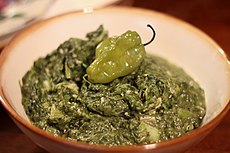Calalu

The various tropical plants of Xanthosoma are called calalú (in English, callaloo; in French, calalou). i> and many other botanical genera that grow naturally in tropical America (particularly in the Caribbean region), either to their leaves and stems that are edible, or to the soups and stews that are made with them. Calalú stews usually include okra, which gives it a viscous texture, as well as some salty meat and spices. It is consumed in the French, Hispanic and English Antilles, as well as on the coasts of Venezuela.
This dish has an African American origin, since the calalú leaves were collected by the lowest castes of the Caribbean colonial society, mainly black slaves, and the okra or okra (Abelmoschus esculentus) is a food brought from Africa.
If we observe the use given to "calalú" in all corners of the Caribbean, we will realize that it does not refer to one thing in particular. In a broad sense, it is a term generic to refer to edible leaves and herbs, but also to the stews that are prepared with them. Likewise, calalú can be eaten raw or seasoned.
Etymology
The most accepted theory is that it is an Africanism, that is, a loan taken from an African language.
The Costa Rican writer Marjorie Ross proposes a Yoruba origin of the word. According to Trinidadian academic Maureen Warner-Lewis it is a Kimbundu word, although she also suggests a possible Americanism. Kimbundu is a language spoken in Angola, and this is the most probable origin, since in this former Portuguese colony there is also a similar dish called calulu. From Angola, the slaves brought various aspects of their culture, such as the cult called palo. They took the recipe to Brazil and today there is a dish called caruru there. The Angolan intellectual António de Assis Junior, in his Dicionário Kimbundu-Português (1994) says that in his homeland, the kalúlu is a botanical term to refer to a family of native plants, and highlights how it was originally a plain word, not a sharp one.
The name can be found in the English West Indies with various spellings: calalloo, calaloo, kallaloo... in the French West Indies and In other areas where Antillean Creole is spoken it is called calalou or kalalou. In French Guiana it is known as calou. According to Walker, the calalú is more common in the Portuguese, English, and Creole-French Americas because the origin of their slaves is from Central Africa (the Congo and Angola), while the slaves of Spanish America came from West Africa (the Kingdom of Benin, present-day Nigeria).
Consumption





Africa
Leaves occupy an important place in the diet of Africans, particularly in West Africa. Leaf stews, such as Guinean bambucha or Ghanaian sigase, are often cooked with palm oil, tomatoes, onion, and hot peppers. In Angola, kalulu is the stew of okra and other vegetables, fresh or dried fish, mushrooms and palm oil. It was one of the typical foods of the ancient kingdom of Ndongo, in which many people were kidnapped and enslaved (in the context of the Atlantic triangular trade).
Cuba
In the provinces of Ciego de Ávila, Cienfuegos, Villa Clara and Sancti Spíritus, calalú is a soup. Its origin, according to Cuban anthropologist Fernando Ortiz, dates back to the introduction of people from the Mandinka ethnic group, from Africa. In Cuba, calalú is a stew made of taro (Colocasia esculenta) and other vegetables, and in Santero rituals it is an adimú (offering) to Changó, "king of kings" of the orishas.
French West Indies
In Haiti it is a typical soup called callalou-gonbo, in which callalou leaves are accompanied with a variety of ingredients: chicken, beef, djondjon mushrooms, sirik crabs or salt beef. Gonbo or gumbo may be a corruption of Congo. It is accompanied with rice or tonmtonm (fruit puree). It is consumed as part of a ritual to vigil for the dead, which is why it is also called "calalú for the dead." A popular Haitian proverb says yon sèl dwèt pa manje kalalou ('calalú cannot be eaten with a single finger'), that is, "we must work together to achieve a goal."
Calalú is also consumed in Guadeloupe and Martinique.
English West Indies
In Jamaica, the stew made with calalú is known as pepperpot, and includes yams and beef. The so-called Spanish callaloo, is cultivated by blacks in gardens and refers to Phytolacca octandra.
In the gastronomy of Trinidad and Tobago, callaloo is a classic. This stew is prepared with unripe ocumo leaves and okra. It is eaten on Sundays and has been identified as the national dish of Trinidad and Tobago. It is accompanied with foo foo (fufú).
Limón, Costa Rica
Calalú is typical of Limón cuisine, and the leaves come from the plant Phytolacca icosandra. Another leaf similar to spinach or calalú is yocotó, which is also harvested and stewed. In Nigeria, a very similar edible plant is known as sokoyokotó (Celosia argentea).
Guyana
The Indian communities of Guyana have adopted this dish. However, "elephant ear" leaves (malanga or ocumo) are not used, but rather bhaji (amaranth) or pak choi (Chinese spinach in Spanish, ) leaves are used. i>red-stripe amaranth in English).
Sucre, Venezuela
In the Paria Peninsula, calalú is a stew of okra, ocumo leaves (Xanthosoma) or belembe (Xanthosoma brasiliense), other vegetables such as purslane or cabbage, coconut milk and goat or chicken meat. According to the Dictionary of Venezuelan Cuisine, "it is clearly African-American influenced." It was introduced from the neighboring island of Trinidad.
Contenido relacionado
Tablespoon
Defrosting (food)
Chuno